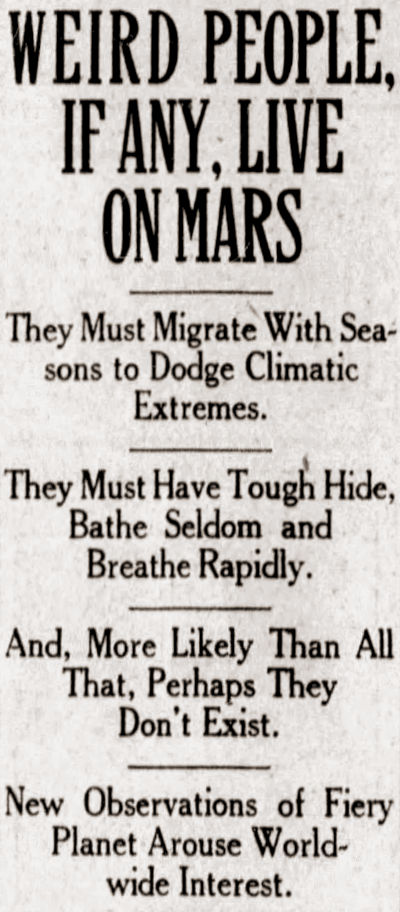
BY J.E. POOLE (by Cable is The Province)
LONDON, Oct. 27. —Unusual interest and widespread preparations are being made In Britain to watch and listen to the planet Mars at midnight on Wednesday. Dr. Stevenson, director of the Mars section of the British Astronomical Association, says he has already observed great changes in the face of the planet, large regions being much darker In coloring than in 1924 while other regions have changed their shape completely, notably In the case of the “Lake of the Sun,” which is completely altered In form. Abbe Moreaux, director of the Bourges Observatory, says that Mars is colder than Siberia.
All over England specially constructed powerful wireless and broadcasting sets will be utilized in an effort to catch any possible signals transmitted by Martians.
By JOHN BOETTEIEGER
YERKES OBSERVATORY. Williams Bay, Wis., Oct. 27.—Mars, within 42-500,000 miles of earth and shining in majestic brilliance through a firmament coming nearer in modern times to approaching the ideal of the astronomers, still holds fast its secret of the ages.
There may living Martians; there probably are none. That rather turns up the situation right after the eminent star-gazers at the observatory here have spent hours gazing at the tantalizing fiery war planet. But if there are humans on Mars, and Prof. Edin B Frost gives a genial, skeptical chuckle as he discusses it, then they are truly weird creature. for the observations have shown Prof. Frost, who is in charge of the work here for the University of Chicago, that certain phases of life on the planet would he most unpleasant.
The professor grants that the present days are the best given since the days of the first telescope for a study of Mars since the planet has come relatively near to earth. It came closer two years ago, bust appeared tower in the heavens and the hazy mists over the celestial equator intervened. As to the physical makeup of the distinctly theoretical Martian, based on last night’s and previous observations, made, here and elsewhere. he is thin sort of creature, Prof. Frost suggests:
MUST BE MIGRATORY.
He must migrate between his north and south hemisphere with the seasons, for undoubtedly the temperatures of all parts of the planet at certain times of the year are far too low to sustain higher forms of life.
“He must have a hide that will protect him from an extremely low temperature and be able to shed it daily when the sun is high, for between night and day there in probable variation in temperature of some 150 degrees Fahrenheit.
“He would perforce breathe most rapidly, for the oxygen on Mars, our observations indicate, is thirty times more rare than on the topmost peak of Mount Everest.
“And it Is certain that his baths must be most infrequent for the amount of aqueous vapor over Mars is far less than over Mount Wilson, 6000 feet above the desert.
PLANT LIFE PERHAPS.
“Altogether the Martian is extremely uncomfortable, and while we can not do away with him positively, we are confident he is not there. As to plant life, we can not say definitely it is there, but we believe it is.”
With all the popular conjecture over possible life on Mars conjecture which has led earnest-minded scientist Lists to believe they have seen artificial canals on Mars’ surface have: been light flashed from there and have heard weird signals over their radios, Prof. Frost offers the distressing supposition that we all are possibly a million years, more, or less, too late.
“Assuming, as we are inclined to do, that there is no human life on Mars,” Prof. From pays, “we come to the question of whether there may tie life In the future, or has been life in the past. “It in most reasonable to believe that life has come on Mars rather than it will come In the future,”
THEORIES CONJECTURAL
CHICAGO, Oct. 27.—Prof. Phillip Fox, at Dearborn Observatory, reported views somewhat different from those of Professor Frost, but they agreed that any conclusions regarding the actual conditions on Mars are purely conjecture. Roth professors reported that the snowcap on the upper pole of Mars hap receded to a diameter of 240 miles, indicating that it Is summer time.
(The Province, Vancouver, British Columbia, Canada · Wednesday, October 27, 1926)